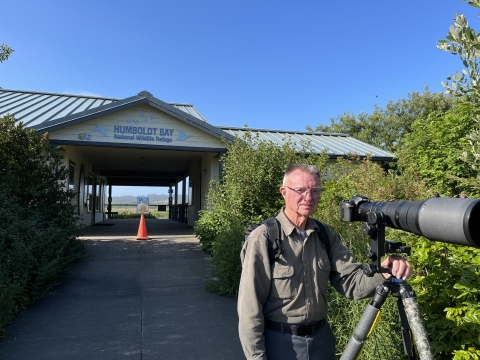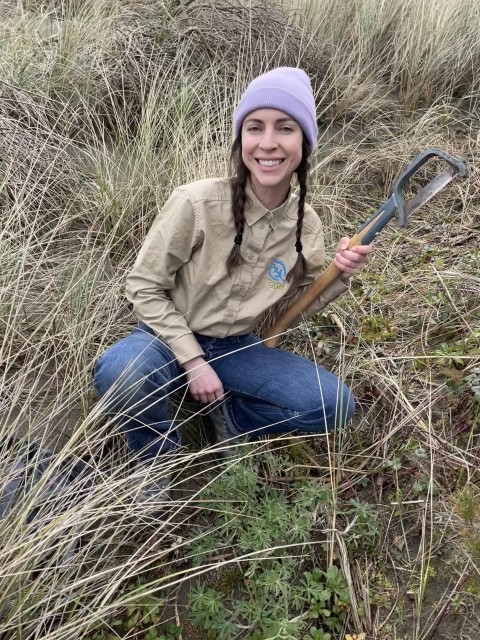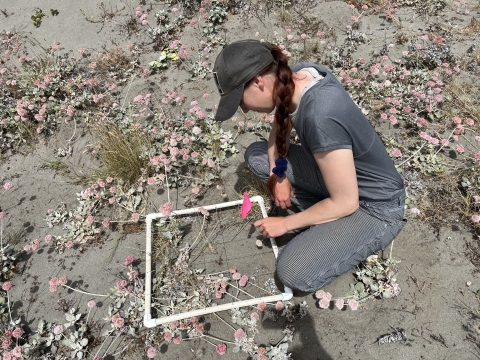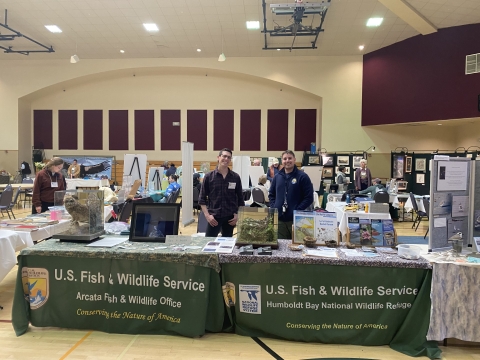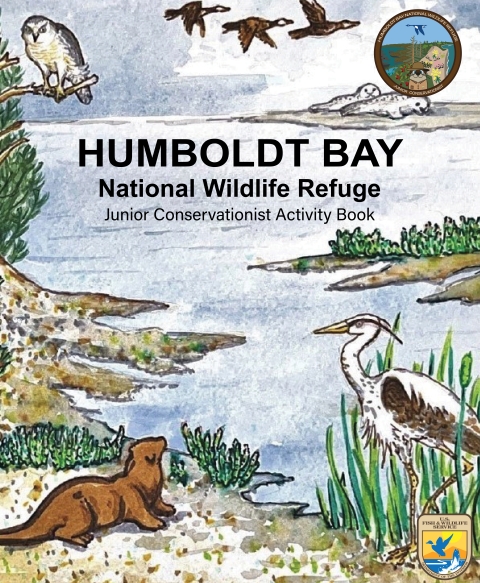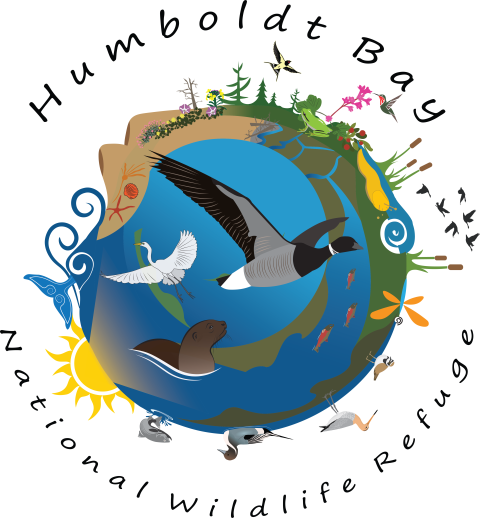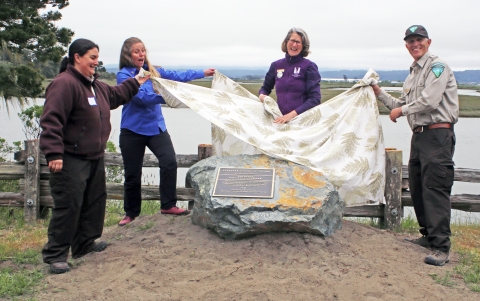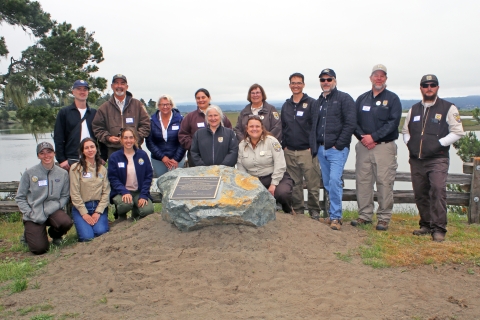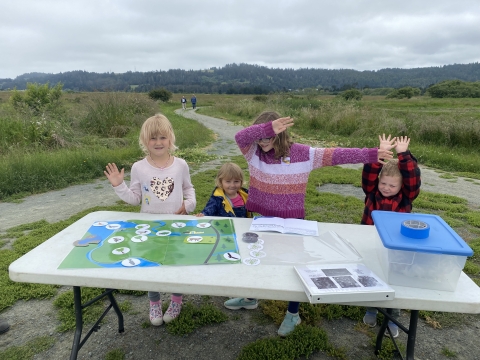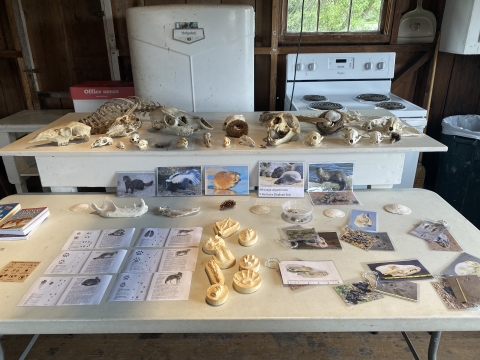A selection of stories that highlight wildlife, conservation, education and community activities at Humboldt Bay National Wildlife Refuge.
In the Spotlight
David Thomson: Refuge Icon
Humboldt Bay National Wildlife Refuge began the year with new projects and innovations, including a new outdoor digital screen installed at the Richard J. Guadagno Visitor Center in April. David Thomson, a professional photographer, wildlife enthusiast and very frequent visitor and volunteer, contributed funding and photographs bringing this to fruition. After coming to the refuge and taking and sharing photos for more than a decade, we conversed with David to learn more about his experiences, feelings, and inspirations prompting him to call the refuge his second home. David’s love for the refuge started in 2008 when he and his wife, Deanna, attended a talk about the Aleutian cackling geese presented by the previous refuge manager Eric Nelson on the Friday night before the Aleutian Cackling Goose Fly Off and Family Fun Weekend.
“I was looking at the pictures, big flocks of geese flying at the refuge and the thought came to mind, I can do that, I can take that kind of picture” said David, who then came to the refuge the very next morning to take photos of the fly off. “I had not a clue what in the world was going on in this place that was packed with people, surrounded by other photographers, and walking the trail with no idea of what was past the visitor center.” Motivated by the challenge and philosophy what am I to be giving to be seen…, David decided to come again with the goal of taking better pictures; over and over until it became part of his life.
“I came to realize that bird photography is very addicting, and I was very fortunate my wife supported my coming here as often as I did, which was almost every day. It is a wildlife refuge, but it is also a refuge for people. It gives us an opportunity to be alone with our thoughts if we want to. It’s a safe place. After my wife passed away, I come here, take my camera, go for a walk and in a short time I feel better.”
Ten years ago, David had a unique experience when he was photographing tundra swans on the refuge. “The sounds that they were making were very low frequency and not very loud, giving the size of the bird I had expected a much louder voice. I thought my wife would love to hear that.” David brought his wife to the refuge to see the swans and told her to look at them through the camera. “The look on her face was priceless, the sense of wonderment that when she realized what she was seeing and hearing…” David and his wife were convinced, at some point they would give the refuge some funds, so another visitor might have a similar experience. After David’s wife passed away in 2022, he talked with Project Leader, Cashell Villa, and Deputy Project Leader, Jason Storlie about officially donating to the refuge. This is when the idea of installing a digital screen came to life.
Before closing the conversation, we asked David what message he would like to leave to the people that visit the refuge, and his response was short and simple, “Open your mind and eyes, and just observe what is around you. Be observant.”
Nicole Matonak: Zoologist in Action
Nicole Matonak is a Student Conservation Association (SCA) intern at Humboldt Bay National Wildlife Refuge. As a graduate in Zoology from Cal Poly Humboldt, Nicole focuses on wildlife research and aspires to help in the conservation of endangered species in other countries someday. Nicole is a passionate naturalist that enjoys being outdoors, one of her favorite hobbies is going “herping” which is a term herpetologists use when studying reptiles and amphibians. Nicole started her internship at the refuge in early 2023, after previously networking with the refuge staff at the Lanphere Dunes Unit. “When I was in college doing my senior project with bats at Lanphere Dunes, I worked in collaboration with Biological Technician, Jillian Zimmerman, and it amazed me how diverse and dynamic dune habitats are, and I expressed to Jillian that I would like to have the same experience of working here every day as she does. When the SCA internship popped up, I said, wow, this is awesome! It’s like a baby step onto the path I want to go down.”
Like previous SCA interns at the refuge, Nicole spends most of her time monitoring species (native and invasive), mapping trails and plant species, managing habitat, working on maintenance, and doing office work. This pathway of learning and practicing, in combination with her degree, has allowed her to gain valuable experience in habitat management and natural resources conservation, including valuable training and certifications offered by the U.S. Fish & Wildlife Service. Along with working for nature, Nicole also highlights the constructive working environment at the refuge. “The refuge staff is lovely. Everyone is hardworking and trying to do their best and that makes me respect this refuge.”
Finally, Nicole shares a message encouraging Humboldt County residents to take advantage of exploring the wildlife and wild areas, emphasizing that we live in one of the most beautiful places in California. She also invites new young naturalists to do what they like the most. “Try new things and explore new places because that is how you can find your niche and passion.” Nicole also reminds folks about the importance of volunteering in places where you can gain valuable experience depending on your area of interest. “Not only are you contributing to causes that matter, but the work also helps you figure out if you like the fieldwork of your profession. Also, be part of the community that connects with and cares about each other and the environment. Those connections you make will help you get to the places you want to go, and even those you don’t know.”
Wildlife & Conservation
Dune Restoration: The Resiliency of the Humboldt Coast
Degradation of dune morphology and biodiversity in Northern California started a long time ago when Euro-American pioneers brought European beach grass (Ammophila arenaria) to stabilize the dunes to protect infrastructures such as railroads and highways from getting covered in sand.
Consequently, European beach grass continued spreading replacing native vegetation with non-native, making dunes no longer functional and depleting biodiversity. Dune restoration efforts around Humboldt Bay, began in 1985, when The Nature Conservancy hired a full-time restoration manager for the Lanphere-Christensen Dunes Preserve, which then passed to the U.S. Fish & Wildlife Service in 1997 to become part of the Humboldt Bay National Wildlife Refuge Complex.
Since then, the Humboldt Bay refuge has been responsible for managing more than 1,000 acres of dunes at the Lanphere, Ma-le’l, and Wadulh Units. In 2015, Professor. Ian Walker from the University of Santa Barbara started collaborative long-term research titled “Restoration of Invaded Dunes to Promote Climate Resiliency” at the Lanphere Unit, to understand dunes resiliency and response to climate change climate change
Climate change includes both global warming driven by human-induced emissions of greenhouse gases and the resulting large-scale shifts in weather patterns. Though there have been previous periods of climatic change, since the mid-20th century humans have had an unprecedented impact on Earth's climate system and caused change on a global scale.
Learn more about climate change . Andrea Pickart, an ecologist that has studied the dunes in Humboldt County for decades, and a collaborator on this research, explains the theories, methods, and results behind this new experiment.
Starting with the premise that native dunes are more resilient than invaded dunes, researchers divided 1.6 acres of dunes into 4 sections. While invaded dunes served as the control group (no treatment applied), the other 3 sections received random restoration activities, including invasive plant removal (manually) and American dune grass (Elymus mollis) planting for one section, and the other with a mix of two types of grass, American dune grass dune mat for a second (a mix of native herbaceous perennials), and a mix of American dune grass and dune mat for the third. Twice a year, researchers evaluated weather data and surface elevation, Pickart explains that the control group did not change at all, but the restored dunes gained volume and height over time. Andrea emphasized one important discovery made by the PhD student Zach Hilgendorf, which was the quick reconnection of sand budget in restored dunes, “after you get a bad storm, which we had two of the first year we were doing this, the foredune scarps (cliffs) and at that point, sand coming from the beach cannot get up to the top of the dune. The way the foredune reacts is the sand slowly builds up a ramp and when the ramp reaches the top, the sand can go up again. Recovery happened two years faster in restored dunes than invaded ones.”
In an era of climate change, preserving natural barriers is crucial to help mitigate weather impacts, especially for coastal communities. Pickart stresses these findings as an alternative to mitigate extreme events coming to California in the future. “We’re going to get more extreme events more often, let’s say you are an invaded dune (non-functional), and you get clefted, it takes longer to build a ramp, so before you get halfway there another big storm hits, and in that time, it carves out the foredune and causes shoreline loss; meanwhile in native dunes it builds up ramps quicker and the sand moves up. We need the sand to reach the back dune.”
Even when dunes are considered easy to restore compared to others, later successional habitats, keeping invasive species invasive species
An invasive species is any plant or animal that has spread or been introduced into a new area where they are, or could, cause harm to the environment, economy, or human, animal, or plant health. Their unwelcome presence can destroy ecosystems and cost millions of dollars.
Learn more about invasive species away is still a problem that requires continuous evaluation and treatment. The refuge staff at the Lanphere Dunes Unit works hard every day to bring dunes back into their original form. Even when there is plenty of work to do, years of restoration have had significant positive impact to our landscape, which brings us closer to victory than we were in the beginning.
Community & Outreach
Godwit Days Spring Migration Birding Festival
Staff and volunteers from the Refuge and the Arcata Field Office of the U.S. Fish and Wildlife Service collaborated on outreach at the Arcata Community Center during the Godwit Days Spring Migration Birding Festival April 14 -16. After 3 years on hold due to the COVID-19 pandemic, it was joyous to return to an in-person event where we were able to talk with people and celebrate our shared interest in nature. The festival provides many opportunities. Attendees might see tens of thousands of shorebirds in migration; visit spotted owls in the redwoods; learn bird calls; photograph birds at all elevations; identify dragonflies and damselflies; search for amphibians; observe coastal flora; view children’s artwork; learn from renowned keynote presenters and numerous government and non-profit organizations; see 100+ birds on the Big Day trip or spot a rarity! For more information, visit https://www.godwitdays.org/
Humboldt Bay National Wildlife Refuge Junior Conservationist Activity Book Released
This activity book focuses on teaching natural science topics such as ecology, wildlife biology, geology, restoration, endangered species, and conservation principles and promotes respect and curiosity for wildlife by using interpretive, cognitive, and ethical skills. Although the book is primarily intended for 4th to 6th grade students, it contains several fun simple activities everyone can do. Once you complete all the required activities, go to the Richard J. Guadagno Visitor Center, and receive your Jr. Conservationist award sticker and prizes.
We highlight the following contributors, David Thomson (wildlife photographer), Denise Seeger (environmental educator), Peggy Murray (artist and educator), Cashell Villa (wildlife biologist), Steven Lewis (equipment operator and engineer), and Kevin Soto (biologist). Thank you all for your contribution toward making this activity book possible. Pick up your free copy at the Richard J. Guadagno Headquarters & Visitor Center today!
Humboldt Bay National Wildlife Refuge Logo Released
Many refuges in the National Wildlife Refuge System have their own local logos that highlight important elements that identify them, and Humboldt Bay NWR is no exception. Our new logo is composed of a sphere that balances the complex connection between the ocean, dunes, dune forest, saltmarsh, wetlands, and bay habitats creating a beautiful mosaic of biodiversity. Starting in the ocean you can see a whale tail, shells, a sea star, and kelp. Moving into the dunes, a sampling of native coastal vegetation such as beach buckwheat, yellow sand verbena, beach morning glory, and Humboldt Bay wallflower are represented. Then the forest, including a skeleton tree, knickinnick, shore pine and red-flowering currant, is fringed by freshwater wetlands that host pacific tree frog, barn swallow, hummingbird, banana slug, cattail, geese, and dragonfly. All of this surrounding abundant saltmarsh and bay there where river otter and great egret live year-round and coho salmon migrate along with black brant, Northern pintail, killdeer and marbled godwit.
We’re very happy with our new illustration, and to celebrate the refuge has released new stickers of the logo for all visitors. Stop by the Richard J. Guadagno Visitor Center and get your free refuge logo sticker.
Morris Elementary School Science Night Outreach Activity
On May 4, Nicole Matonak and Kevin Soto hosted a wildlife observation station at Morris Elementary School Science Night in McKinleyville. During this activity, kids and parents had the chance to learn the difference between carnivore and herbivore skulls, ID wildlife, and find out how to use trap cameras to monitor wildlife.
Lanphere & Ma-le'l Dunes National Natural Landmark National Natural Landmark
The National Natural Landmarks Program preserves sites illustrating the geological and ecological character of the United States. The program aims to enhance the scientific and educational value of the preserved sites, strengthen public appreciation of natural history and foster a greater concern for the conservation of the nation’s natural heritage. The program was established in 1962 by administrative action under the authority of the Historic Sites Act of 1935. The first National Natural Landmarks were designated in 1963. Today, there are more than 600 National Natural Landmarks in 48 states, American Samoa, Guam, Puerto Rico and the U.S. Virgin Islands.
Learn more about National Natural Landmark Plaque Dedication
On Thursday, May 18, over 70 people gathered at the northern section of the Ma-le’l Dunes Cooperative Management Area (Ma-le’l North) to celebrate the designation of the Lanphere-Ma-le’l Dunes as a National Natural Landmark. The National Natural Landmark Program, administered by the National Park Service, formally recognizes a site as possessing outstanding biological or geological features, providing an important example of our nation’s natural history. National Natural Landmarks are designated by Secretary of the Interior after in-depth scientific study. Designation is based on the site’s condition, illustrative character, rarity, diversity and value to science and education.
The Lanphere-Ma-le’l Dunes represents one of the most diverse and highest quality coastal dunes habitat in the North Pacific Border Bio-physiographic Region. The site is very scenic and affords the public an inspiring view of a natural coastal ecosystem that was once common and is now nearly lost. The site also affords a special opportunity to study the natural relationships among dune organisms and physical processes.
The event included an opening ceremony with Wiyot Tribal Chair, Cheryl Seidner. Humboldt Bay National Wildlife Refuge Project Leader, Cashell Villa, introduced each of the following speakers: John Driscoll, representing Congressman Jared Huffman, Heather Eggleston, Program Manager, National Natural Landmarks Program, Jennifer Wheeler, Bureau of Land Management Assistant Field Manager, and Jennifer Ortega, California Conservation Corps. All speakers referred to the effort and determination involved to achieve this designation. Thanking community individuals and organizations presented in the audience for their work. A National Natural Landmark Dedication Plaque was unveiled, and refreshments and conversations were enjoyed. Interpretive media was distributed and on display, including a history of conservation of the Lanphere Dunes by Jacoby Creek School sixth graders, Myka Nannizzi and Nova Garwood (they won the Humboldt County History Day competition this spring, and were finalists at state!)
Finally, many folks embarked upon one of several guided tours offered of the incredible north coast dunes. To learn more about free guided walks in the dunes, visit www.friendsofthedunes.org.
Junior Conservationist Day
On Saturday, June 10, Humboldt Bay National Wildlife Refuge hosted the first Junior Conservationist Day. This activity inaugurated the Jr. Conservationist Activity Book and helped participants to complete some activities by offering specific corresponding stations. The first station was “Exploring Endangered Species” with Kinsley Kaeser, which involved visiting the IUCN Red List platform online and and analyzing the status and factors influencing species populations. Kevin Soto presented the “Trapping Camera and Wildlife Tagging” station, showing how trap cameras work as essential tools not only for research but also law enforcement when fighting illegal poaching. This station also had a tagging activity where participants identified photos of wildlife using observation skills.
At the “Conservation Scenario” station, Denise Seeger assisted participants with critical thinking to solve two different conservation issues. One scenario looked at Humboldt Bay NWR as an example of habitat management and the second scenario focused on species protection, with Western Snowy Plover as an experimental group. Finally, at the “Tracking Wildlife” station, Nicole Matonak showed participants how to analyze and recognize tracks from different animals, including how to differentiate between predator and prey using measurement, patterns, and observation.
Thanks to all our volunteers, including Gail Marshall, who welcomed and introduced participants to the event, and to Mike and Peggy Murray, and Steve Williams, who staffed the Visitor Center.
Explorando Juntos La Bahia de Humboldt - Exploring Together Humboldt Bay
On June 24, several families participated in this second annual bilingual activity co-hosted by Friends of the Dunes and Humboldt Bay NWR. The wetland exploration took place along the Shorebird Loop Trail near the freshwater ponds around the Gazebo. Participants learned about wetland ecology and participated in fun activities like macroinvertebrate ID, catching frogs, birdwatching and wetland watercolor painting.
Activities like this serve as bonds between the refuge and nonprofit partner organizations and connect people from different ethnicities together by providing multilingual interpretation. Thanks to volunteer Connie Doyle for her macroinvertebrate expertise and Daisy Ambriz from Friends of the Dunes for her passion and dedication in gathering our community and connecting them with nature, especially Hispanic families.

